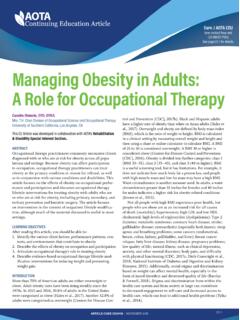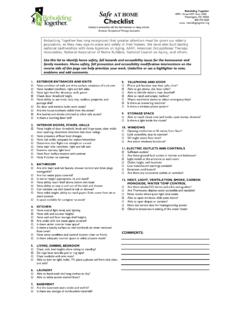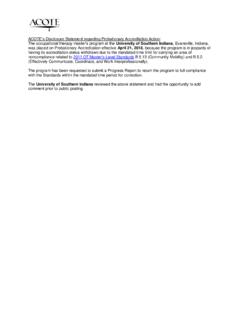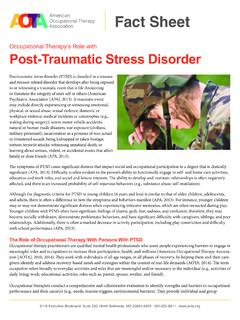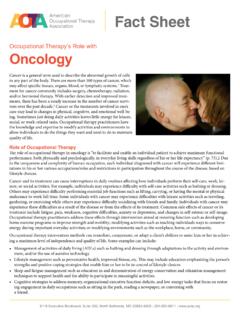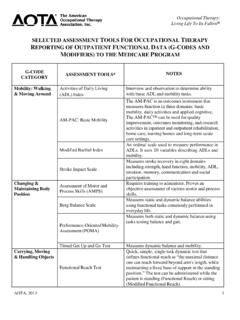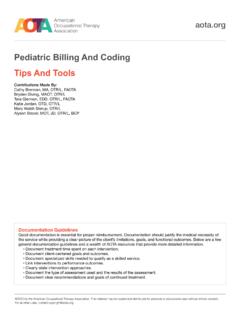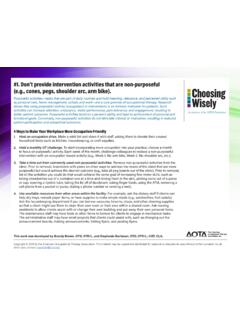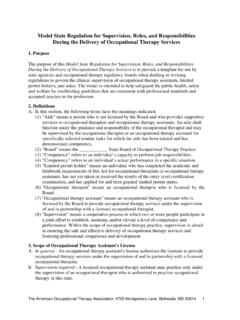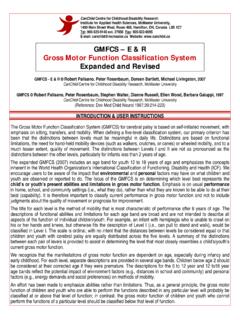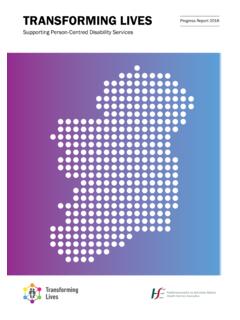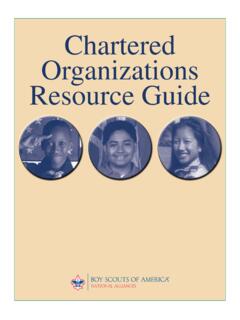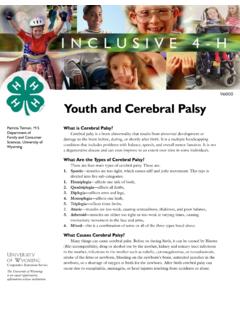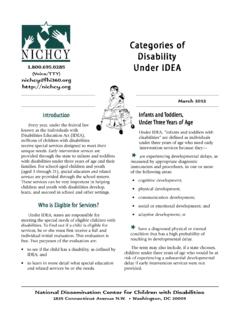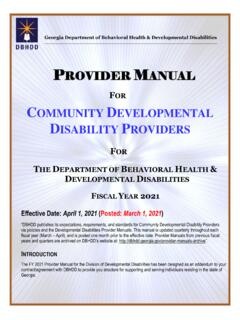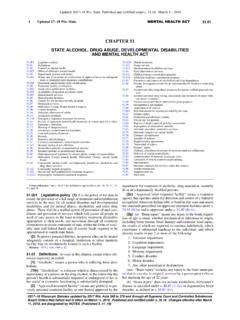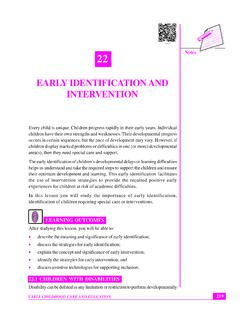Transcription of Evaluation of Feeding, Eating, and Swallowing for Children ...
1 CE-1 Earn .1 AOTA CEU (one contact hour and NBCOT PDU). See page CE-8 for Education ArticleCE-1 ARTICLE CODE CEA0321 | MARCH 2021 Evaluation of feeding , eating , and Swallowing for Children With cerebral PalsyKate Barlow, OT, OTD, OTR Assistant Professor of American International CollegeSpringfield, MA Kelsey Sullivan, OTSO ccupational therapy student at MGH Institute of Health ProfessionsBoston, MAThis CE Article was developed in collaboration with AOTA s Children & youth Special Interest SectionABSTRACT Most Children with cerebral palsy (CP) also have a pediatric feeding disorder (PFD). Evaluating feeding in Children with CP is a highly complex process that is best done in a team environment.
2 This article describes the prevalence of PFDs in Children with CP and highlights the special clinical considerations of the occupa-tional therapist in evaluating PFDs in Children with CP. LEARNING OBJECTIVESA fter reading this article, you should be able the elements of PFDs resulting from CP that requirespecial the typical phases of Swallowing and the impact of the role of the occupational therapist in assessingeach phase of swallow for Children with and Swallowing are ADLs that individuals learn to master to independently function and take care of themselves (American Occupational Therapy Association [AOTA], 2020). Impairment in one s ability to properly and safely complete necessary ADLs may lead to a decreased perception of their quality of life (QoL) (Ede-mekong et al.)
3 , 2020). When a child is born, they must rely on caregivers to complete basic ADLs; however, as they grow, chil-dren learn to complete these tasks for themselves. The motivation to do so is linked to an innate feeling of competence and satis-faction when successfully completed independently (Shepherd & Ivey, 2020). When a child is born with a disability, the capacity to perform certain ADLs may be impaired, thus interfering with feelings of autonomy, self-esteem, and self-determination (Shep-herd & Ivey, 2020). Children born with cerebral palsy (CP), the most com-monly diagnosed motor disability in Children , have motor, cognitive, and perceptive impairments that affect their ability to complete many ADLs (Erasmus et al.
4 , 2012, p. 409). Of importance, several studies suggest that Children with CP have a particular difficulty in completing various tasks associated with feeding . Dysphagia, the impaired ability to swallow, is prevalent in more than half of all Children with CP and is the leading cause of death in individuals with CP (Novak et al., 2020, p. 10). Additionally, Children with CP are chronically classified as malnourished for reasons that include oral motor dysfunction, chewing disorders, and postural abnormalities (Inal et al., 2017). The complexity of CP cases with comorbid conditions, par-ticularly feeding disorders, requires a qualified team approach when evaluating and treating for various impairments during both volitional and reflexive phases of feeding and swallow-ing.
5 The purpose of this article is to highlight the prevalence of feeding disorders in Children with CP, and the role of the occupational therapist (OT) in evaluating Children with CP who have feeding difficulties. Evidence-based Evaluation and treatment considerations for this specific population will be reviewed. Earn .1 AOTA CEU (one contact hour and NBCOT PDU).See page CE-8 for EDUCATION ARTICLECE-2 Earn .1 AOTA CEU (one contact hour and NBCOT PDU). See page CE-8 for CODE CEA0321 | MARCH 2021CE Article, exam, and certificate are also available ONLINE. Register at or call toll-free 877-404-AOTA (2682).Continuing Education ArticlePREVALENCE OF CP IN THE UNITED STATES AND GLOBALLY CP is the most common pediatric motor disability in the United States, affecting approximately 2 per 1,000 live births, or around 10,000 births a year (Poinsett, 2020).
6 Furthermore, it is estimated that more than 750,000 Children and adults have this motor disability. Globally, there are approximately 50 million individuals living with CP who require rehabilitation services (Cieza et al., 2020). Although CP is the most commonly diagnosed motor condition in Children , its exact cause has not been identi-fied ( cerebral palsy Alliance, 2015). Research has identified several risk factors associated with high rates of Children with CP, including low birthweight and premature birth, multiple pregnancies, and maternal infection (Reidy et al., 2020). Additionally, higher rates of CP are diagnosed in males and non-Hispanic black Children (Stavsky et al.)
7 , 2017). A child with CP is diagnosed according to one of four main types, including spastic (80% to 86% of cases), dyskinetic, ataxic, or mixed (Stamer, 2016). Hallmark symptoms depend on type, but they commonly include reduced gross motor skills, poor postural control, and abnormal muscle tone, which all affect function (Labaf et al., 2015). Although not considered hallmark features of the con-dition, feeding difficulties affect 70% to 80% of Children with CP (Korth & Rendell, 2015). Additionally, drooling and Swallowing difficulties were estimated to affect 44% and 50% of individuals with CP, respectively. Individuals with more severe forms of CP and increased impairment in functioning were found to have a higher prevalence of feeding problems.
8 Furthermore, those who had difficulties with feeding showed increased rates of malnutrition and aspiration pneumonia, and an overall decrease in feeding DISORDERSP ediatric feeding disorders (PFDs) affect up to 29% of all Children in the United States (Silverman et al., 2020). Despite the preva-lence of such conditions, there is a lack of awareness and univer-sally accepted definition for PFDs. With influence from the World Health Organization s International Classification of Functioning, Disability and Health, the following definition is proposed: PFDs are impaired oral intake that is not age appropriate and associ-ated with medical, nutritional, feeding skill, and/or psychosocial dysfunction (Goday et al.)
9 , 2019, p. 124). With this definition in mind, PFDs are clearly complex in nature and require a holistic and collaborative approach to Evaluation and may encompass one or more impairments within the domains of medical, nutritional, feeding skills, and/or psy-chosocial dysfunction, thus requiring the child s physician to obtain further information from a range of medical specialists, including, but not limited to, an allergist, dentist, gastroenter-ologist, dietician, psychologist, speech-language pathologist (SLP), and OT (Marcus & Breton, 2013). These specialists aid in the comprehensive Evaluation process and perform tests to assess feeding and Swallowing ability, along with the potential for comorbid addressing the nutritional needs and potential dys-function of this area, a registered dietitian (RD) is often needed.
10 An RD will assess whether a child is obtaining the necessary calories, fluids, and other vital nutrients for optimal growth and functioning, as well as recommend a modified diet when appro-priate (Marcus & Breton, 2013). This specialist has expertise in creating a well rounded and tolerated diet for the child and works collaboratively with SLPs and OTs for effective feeding skill role of OTs in pediatric feeding will be further discussed in detail in the following section; however, they play a crucial role, along with SLPs, in aiding a child with CP to properly develop the necessary skills to feed , psychosocial dysfunction may present not only in the child with a PFD, but also in the parents, caregivers, and family members who tend to the child.
